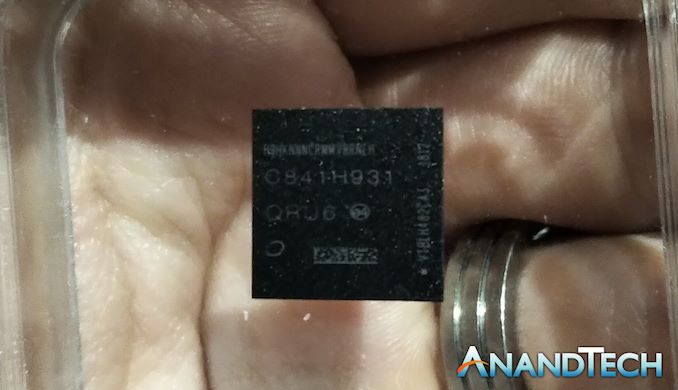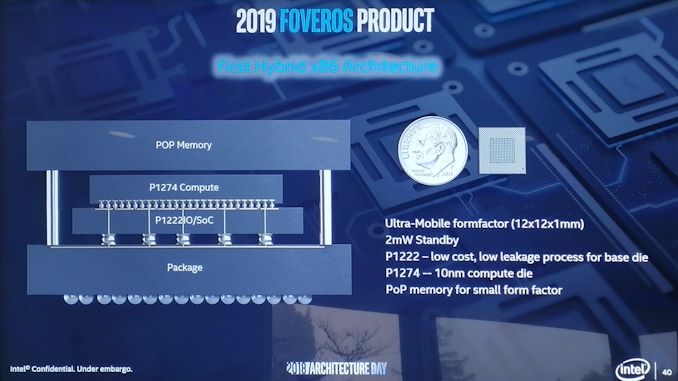Intel Hybrid CPU Starts 'End of Life' Process
by Dr. Ian Cutress on July 7, 2021 4:46 AM EST
As I opened my inbox this morning, I was surprised. I keep track of when Intel puts products on End of Life (or starts the process through something called Product Discontinuance), and so I usually see a run of 3-5 year old CPUs or storage or servers pass through without much of a worry. When I opened up my daily brief today however, the headline read ‘Core Processor with Hybrid Technology Discontinued’, which immediately struck me as a bit crazy.
Intel announced Lakefield, its only Hybrid CPU on the market, in January 2019. It pairs one of its big cores with four smaller Atom cores in a small 12mm square package. Not only this, Lakefield is one of Intel’s first Foveros packaging processors, with a 10nm compute piece of silicon sitting on top of an IO die, all packaged together with DRAM on top. The goal of the Lakefield design was to produce a processor with a super low idle power, but also have enough performance for hand-held devices. Intel quoted 1.2 mW when in idle, meeting that goal.
Lakefield came to market in June 2020 in two products: the Samsung Galaxy Book S 13.3-inch clamshell laptop, and the Lenovo ThinkPad X1 Fold, a foldable display-based design. Both of these products were premium priced, particularly the Fold with its display, however reported performance was more akin to a quad-core Atom notebook than the $2000 quad-core mobile devices they were aiming for. Battery life sounded good, although we have never tested it at AnandTech due to lack of access to review samples from Samsung, Lenovo, or Intel.
The key thing was the Hybrid CPU design. By pairing one of Intel’s big cores with four of its smaller Tremont Atom cores, the goal was to run the device almost exclusively on the Atom cores for efficiency and then call on the big core when anything latency related was required, such as when the user touches the screen or the keyboard. Within 16 milliseconds (or one frame at 60 Hz), the processor would switch over to the big core for the touch screen interaction, do what it needed to do (often in under 16 ms), and then power back down.
In principle, the concept is sound and makes a lot of sense, especially if the goal is to save battery. As Intel’s first Hybrid CPU design however, there were some initial teething issues as managing threads between the different performance levels required adjustments to Windows’ scheduler. Microsoft already has experience with this when dealing with Windows on Snapdragon devices using the Arm architecture, however it was a first for x86 and the first implementations were reportedly quite rough.
In reality, because of the price of the device, it was compared to hardware that had only big cores. Even if it was compared to Atom based notebooks in the $400 range, because the processor was a low powered device, often lower than the Atom notebooks it was being compared to, it didn’t fall favorably in those benchmarks either. The goal of Lakefield for Intel wasn’t performance, but experience and form factor innovation, which benchmarks never indicate.
The note today from Intel indicates that Lakefield is now on the path to End of Life. This means the following milestones:
- Start of Product Discontinuance: July 6th 2021
- Last Corporate Assurance: October 8th 2021
- Last Product Discontinuance Order: October 22nd 2021
- Orders are Non-Cancellable from October 22nd 2021
- Last Shipment Date: April 29th 2022
The start of the process means announcing that they will stop manufacturing processors (July 6th) and if a company wants to put in an order, they have until October 22nd. However that’s also the date where orders can’t be canceled or returned, and all orders will be shipped by April 29th. That means that products could still come out with Lakefield after April 29th, however the OEM partners will not have any means to secure additional stock.
Intel has set its sights on its future Hybrid CPU designs, with the upcoming Alder Lake platform set to launch end of this year in either desktops or notebooks. There is also talk that Windows 11 is better suited to deal with Intel’s hybrid designs from a scheduler perspective. Overall, to see its only public Hybrid CPU suddenly go on product discontinuance after only a year in the market isn’t a great commitment to the technology from OEM partners. Intel's own Product Change Notification states that 'market demand for the products listed has shifted to other Intel products'.
Related Reading
- The Intel Lakefield Deep Dive: Everything To Know About the First x86 Hybrid CPU
- Intel Discloses Lakefield CPUs Specifications: 64 Execution Units, up to 3.0 GHz, 7 W
- Samsung Unveils Intel-based Galaxy Book S: Intel’s Lakefield Inbound
- Lenovo’s ThinkPad X1 Fold: Combining Foldable Displays, 5G and Lakefield into a… Laptop?
- Intel: Lakefield in 2020, Possible 5G on Foveros
- Intel's new Atom Microarchitecture: The Tremont Core in Lakefield
- Hot Chips 31 Live Blogs: Intel Lakefield and Foveros
- CES 2019 Quick Bytes: Intel’s 10nm Hybrid x86 Foveros Chip is Called Lakefield








_carousel_thumb.jpg)










58 Comments
View All Comments
mode_13h - Thursday, July 8, 2021 - link
> You compare a Windows laptopForget about the comparison.
My point is that Lakefield's failing was that it targeted premium Windows notebooks/tablets at a price point that will mostly restrict it to executives of corporations who love to lard up their Windows PCs with multiple layers of security software such a low-power CPU can't handle. This product was doomed from the start.
Qasar - Friday, July 9, 2021 - link
" My point is that Lakefield's failing was that it targeted premium Windows notebooks/tablets at a price point that will mostly restrict it to executives of corporations who love to lard up their Windows PCs with multiple layers of security software such a low-power CPU can't handle. "that sounds more like the execs of corps fault then lakefield, or windows. id guess if you removed all that lard, the notebook would run pretty well, if those same execs spent a little more money, on a comp that could handle all that lard, the experience probably would of been better.
mode_13h - Friday, July 9, 2021 - link
> that sounds more like the execs of corps fault then lakefieldI'm just offering the single datapoint of my experience of running a corporate Windows 10 image. Take it for what it's worth, but it sounds like I'm not the only one in this boat.
Building a successful product is partly about knowing your market well enough to choose the right specifications. We can't say that was definitely an issue, here, but I think it'll be telling if Intel doesn't follow it up with anything similar.
Oxford Guy - Sunday, July 11, 2021 - link
Great point. A machine that isn’t doing anything is bound to be fast at it.FreckledTrout - Wednesday, July 7, 2021 - link
I think you are saying Windows is the problem because of all the security software? Anyhow we have 4 security products on our enterprise laptops and it does eat into performance. If you can get a quad core ore more along with a fast M.2 SSD it helps a lot. You do need the better IO as well.29a - Wednesday, July 7, 2021 - link
Not to mention how much Windows runs software compatibility telemetry in the background. I usually have Task Manager running and any time my computer starts running like shit if I look at Task Manager I will see software compatibility telemetry is running in the background using 100% of the hard drive capacity. It would be so nice to be able to disable that shit completely, it's why I hate Windows 10.brucethemoose - Thursday, July 8, 2021 - link
You can, via the registry or maybe a group policy option.GeoffreyA - Friday, July 9, 2021 - link
Take a look at ShutUp10. Good tool.Oxford Guy - Sunday, July 11, 2021 - link
Telemetry? Yes. Most/all of it being about software compatibility? Ha.mode_13h - Wednesday, July 7, 2021 - link
> If you can get a quad core ore more along with a fast M.2 SSD it helps a lot.I know the H-series machine has a decent M.2 NVMe drive, though I forget which model. I couldn't believe it, because the machine performs as though it has a spinning hard disk. All the drivers are up to date and it has passed diags several times.
It has a Nvidia dGPU and 32 GB of RAM, as well. They didn't skimp on the HW specs.